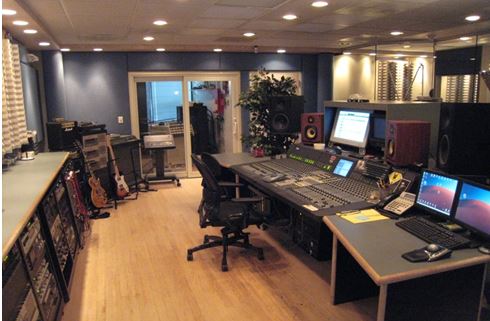New Zealand Music Community
| Page 1 of 1: [ 1 ] | ||
| Shade
muzic.net.nz Admin Joined: 17/07/02 Posts: 5067 Location: Manawatu View Profile |
FYI: Recording Studio Etiquette Posted: Tue Jun 7, 2016 9:16 am For many musicians, the opportunity to record the outpourings of their heart and soul is a dream come true. After many years of honing and perfecting their abilities as an artist, they may well end up in a studio singing the outpourings of their soul. There are a number of elements to that scenario that need to be understood in light of the recording studio experience. What I want to talk about is probably more the process that surrounds the relationship and the conduct of artists and operators of professional studios in bringing the best piece of music created in the modern studios of today, that money can buy. The first time I walked into a professional recording studio many years ago, I was struck by the general order and the neatness of the working environment. Having seen the insides of many a studio, both professional and home, I have always enjoyed the diversity and paradoxically, the sameness of the studio environment. The one thing that a studio environment brings that the live stage does not is the discipline of sound control. For those of you who have already spent time in studios you will know the difference in the dynamics that you experience between a live audience and a recording studio especially when dealing with the sound engineer or producers comments and directions. A studio can become more intimidating and emotionally crushing than an angry or indifferent crowd if handled the wrong way. Generally on a live stage the results of your offerings are pretty honest and unless you make an idiot of yourself, are generally supportive. The studio ‘audience’ may not be quite so appreciative and in fact, even more critical in ways that you have never imagined. Firstly the stage persona that you might adopt for live performances is quite likely out of place in the studio. Secondly the focus in the studio is on the tone, clarity and separation of the music, the quality of the singing, and not the persona that is delivering it. Having run and operated my own studio for many years both in a professional environment and in a home set up, there is a world of difference to the live stage and to studio performance. So without any more pre amble let’s get to it. Preparing the sound stage Firstly there are some standard activities and understandings that both parties are going to do and have, before anyone hits the record button. You, the artist or band, are going make sure your instruments are placed and arranged in the appropriate spaces indicated for the recording session. This may sound a bit obvious, but you would be surprised at how much consternation the simple act of determining the position of instruments can bring with it. This process will be subject to discussion on how the band wants to be recorded, either one instrument at a time, or depending on the space available, if the band wants to play together the same way that they practice and perform. The recording technicians, also known as audio engineers will have made some preparations too. These preparations will be based on the knowledge they have of what you and/or your bands recording intentions will be, as well as the size of the session coming up. It might be as simple as a quick tidy up by putting microphone stands, cables and accessories away or they might find it necessary for a whole reset to the sound stage as well as reconfiguring the control room to handle a much larger job. You the artist, will already have been through a number of stages before you even get to this point. Those stages will include a range of career decisions going from such thoughts as, do I /we need a cd for what we are already do, do we have the money to make this happen, will we get a better return for our efforts by selling these cd’s at gig’s, can we get air play and so on. So to find yourself in the studio at this point is the result of a road that you are already well and truly been travelling on. In reality, the staging and set up process can take anything from a number of hours to a day or two, depending on how much equipment is being brought to the session and what special needs of the artist or group there might be. Consider for a moment the logistics for getting a 70-100 piece orchestra seated, sound isolated and miked up, to say for instance, a six piece rock band or a three piece Jazz band. I think you can see where this is going; the more paraphernalia you bring to the recording, the more preparation there is for the technicians to set up for, and the more time it takes to record it. However don’t think that stripping yourself of the normal gear that makes your sound is a forgone conclusion, it will only set you up to fail as it is your sound, whatever it is, it is what they are preparing to record. So the art of compromise becomes the key to success in this process. It is not just about tuning your musical instrument and throwing a microphone in front of it, but in this process it is also about understanding what the science of sound control brings, so capturing its creation can become rather complicated. For those of you who have played in a more professional capacity, the protocols and procedures that are employed by a PA business to broadcast your performance to a live audience, will know that it takes some time and expertise to complete the process. Interestingly enough, the sessions that are recorded from a live performance do not differ that much from the studio session, in that the similarity of how the instruments are carefully connected, isolated and miked. However the studio becomes a lot more focused on perfectly recording the sounds generated and then manipulating it to create the blend of music that becomes your song. You will quite likely end up playing the same piece of music many times over as you work to get the perfectly recorded track/s for each instrument. The Studio Atmosphere The studio environment can be pretty intense. Although great effort is made in the larger commercial studios to cater to the clients comfort, there are a lot of people all focusing their individual skills and talents on bringing your music to life, which can make for a stressful time. Can I say here that although the environment can be very intense, it can also be the most creative and rewarding time of your life, because this is the best place to explore possibilities and ideas, provided you have the budget. The people involved in this process can vary from the studio owner/manager who wants a happy client, to the staff working behind the scenes, co-ordinating the recording session, the band manager, accountants, lawyers, marketing managers and media etc. Then there are the people in the control room and on the ground, facilitating setups and re-structuring sound stages and isolation booths. To the uninitiated this environment can be intimidating but at the end of the day you are all there for the same thing, slightly different agendas but it’s all about the music, right?.....Hmmm maybe not. Maybe this is a good place to address another aspect of the recording experience. The Business of Music This is where reality bites because we are unfortunately confronted with a few of the realities that attend this process. Initially when contemplating this process, there is the first restraint of money, the recording budget. If you are a celebrity with millions in the bank, then this isn’t quite the same concern as it might be to the new band struggling to cut a demo, or their first EP to sell at gigs or simply for soliciting work. Then there is time; the time that the studio is working with you, because while you’re playing and recording your music, there will be the added pressure at the back of your mind that the studio wants to get you through as fast as is reasonable. The studio has other clients waiting in the wings to record their music too. Remember too that you are quite literally paying their wages, and in the beginning of any musical career that tends to makes thing financially a bit tight. Your time in the studio therefore, can be a very intense and in some ways rushed affair because, for every hour that you are in the studio with the clock ticking, you are paying. However by the same token, be careful not to let the budget and studio constraints determine the quality and value of your work. You have every right to be there and get a quality product for your time and money as much as the next guy. So try to keep the hourly rates and budget thoughts to a minimum. However the dollars can begin to add up pretty quickly, if you don’t pay attention to this side of the process. If you have not done your homework and prepared your music carefully and completely before you even get to the studio, you will be in for a shock. If you can afford the luxury of taking days and weeks to record your EP or album, then this is not a concern, however when you are paying $80.00 to $120.00 an hour and even as high as $500.00 an hour, then it starts to get really expensive and it then becomes prohibitive to work this way. On the flip side if you get picked up by a recording label then generally a deal is worked out where they pay the studio for your recording time and things can be a bit more relaxed. Trust me when I say they will get the money back in spades when your music goes to air……Well that’s the idea right? Record companies are a business after all and they still want to make more money that they have to give away, so be careful how you impose on their generosity. None of us would be who and what we are today without the music, however there is a financial investment that is part of this equation and it needs to acknowledged and respected by both parties. The Studio So let’s get into the studio. Firstly most of the equipment in the studio is very expensive so it needs to be treated with respect and care. If you don’t know about something that you want to use or handle, ask, because you will most likely get it wrong, then you could end up destroying something that might be incredibly expensive and affect the whole process that you and others are relying on, or just plain wipe-out week/months’ worth of work for yourself or even another artist. Commonly you will find a range of mixing desks or one very large one, a number of recording platforms ranging from the old analogue reel to reel tapes in various sizes, to the modern digital systems that are computer based and an array of computer screens and controls to run the dedicated software. Most modern studios offer a mixture of recording formats, the old analogue tape system or the more modern digital computer based systems. Sometimes both are used, or there may be one of each. Some studios will have the ability to go from one platform to the other, all of which being done, “in house” as it were. It would be rare for a studio to not be able to offer your work as a finished product in a non-digital format. Therefore the first array of decisions that will confront you is the format for which you wish to record in and then the reasons for doing that which will be discussed at length both by your band members and manager and the producer assigned to your project. There are some good musical choices that can be made for using the analogue tape format, but it tends to be mechanically complex and brings with it a different set of drawbacks, despite the nature of its sound reproduction. After that, the sound engineer/producer will give some pretty clear directions as to how you or the band may conduct themselves in his/her control room or on the mixing desk, or even in the sound stage where the band will be performing. So if you want to keep working there then you had better pay attention and respect what the sound engineer brings to the conversation on this. Their mixing desk can range from a fairly basic 12-16 track digital or analogue system that has a limited range of functions to a 24/48 plus track desk with more buttons and controls than a jumbo jet; then you really need to stay well clear of it unless you really do know what you are doing.  This is all in the control room, which is separated from the sound stage where the band or artist will be set up, usually a double sided clear Perspex or glass window will give visual access to each other but this is not always the case. Some studio control rooms are completely isolated from the sound stage and rely upon in-house; close circuit TV and a public address system to communicate. Depending on the quality of the studio, the control room environment may be very cosy, warm and welcoming or it might be functional and technically correct for the listening and shaping of sound. It is in this room that most of the creative brain storming will take place and many an instrument will end up in this place to show ideas and or to even record additional tracks. It has not been unheard of for the control room to become a mini sound stage for many a diverse reasons. The Recording Process There are some studios that will offer a situation where the band will play the whole song together in the sound stage area and hopefully not make too many mistakes in is execution. The retakes of the song can become laborious and let’s not forget expensive, because the more time you take to perfect your song at the studio, the more it’s going to cost for the finished product. The recording process itself takes place in a number of ways. Without getting too technical about this, we begin the process by establishing whether or not the artist or band want to have a click track as part of the initial process, which is essentially an audible metronome sound or electronic time keeper for the band to use to gauge their songs timing. This tends to assist the maintenance of timing keeping for the band or artist when laying down an instrument at a time for the initial stages. The click track can be muted later as the pace and feel is established and this allows for the bass, drums and rhythm guitar tracks to be added to take over setting the feel and pace of the song. Can I say too do not be surprised when many an artist is confronted by their inability to keep time whilst playing along to a click track. This is not a new phenomenon but tends to be a concern when it throws into jeopardy the future of the session. This is an aspect that all studio operators will have devised a method on how to resolve. Group Recordings The other side of the coin as it were, is when the whole band or orchestra play together and the specific tracks pertaining to the individual instruments are recorded as a group. Normally these tracks are then routed to a sub group which in turn offers control on the mixing desk for this group or on the recording platform. This second part would apply to multi-instrument recording like an orchestra or ensemble. In this situation the process becomes more complicated because there are more factors that govern the result of the recording process, and the audio engineer may not have the same level of control over that particular part of the music being created. By way of example, if recording a string section that has each instrument miked and one of the violins is not in tune or has been played with a few bad notes, then typically that section will need to be re-recorded as a separate entity. Depending on the way the mixing desk is set up and its connection to the recording platform, be that tape or digital, it will depend on how the sound engineer will find the best way to isolate and then fix the problem. Multiple takes then become the order of the day. Generally, decisions about re-recording such as described are made in the pre- production stage of the process or can be left to fix whilst either still in the production stage or depending on the track layout, re-recorded separately later. I have found through personal experience that fixing these matters at the musician’s end whilst they are still there tends to be more cost effective. Trying to compensate for the mistake/s of an artist or band by using the magic box of filters and signal processing equipment that at times I think we rely too heavily on, rarely proves to be satisfactory. Sometimes it doesn’t matter what you do in the post production stage, the damage is done so just deleting the track and re-recording is the only option. Having said that, we can now digitally isolate the exact part where the mistake was made and re-record that section only. Such are the joys of the digital systems we have today, not impossible with the analogue tape options, just a bit more problematic to facilitate. I think I need to make this point here as well, don’t ever make the mistake of thinking the studio can be used as a practice venue, because it’s not. Especially if you’re sole purpose for being there is to be recorded. Granted there are some studios that have the facilities to offer those services, but you are still going to pay for it, so having your music sorted out before you get to the studio is a definite must. Dealing with the pressure As the recording process begins and continues through the day or night depending, there will be breaks for technical consultation, food, fresh air, toilet etc, all of which will encroach on the time spent in the studio and hence the cost will begin to escalate. Keeping the breaks to a minimum is essential to getting the work done obviously but as you progress through the musical pieces the intensity and the pressure can begin to take effect. Having ways of dealing with the results of the pressure will be a bonus to both the artist or band and the studio. At this point I am not about to make suggestions on how best to relieve that stress but I do want to say that some studios have pretty strict policies on this issue. The use of recreational drugs and alcohol whilst on the premises may not be allowed, so best to check before you light up or crack the lid on a tinny. It could end up being a very short and expensive recording session. Having a contract with the studio where you can suspend payment for certain kinds of breaks is something to be sought after, because there is nothing worse than paying hundreds of dollars while the guitarist goes off and has a screaming match with the singer over some unseen changes to a song. In a situation like that, call it a day, and solve the problem on your own time not the studios, because they will still get paid whether you are working or not. Post production and mixing down Once all the songs have been recorded then the lengthy process of mixing the music and bringing any of the finishing touches to the songs become the final step in completing the music. When mixing down the songs, it may take place in the same environment as the where the recording was done, or it can all be shifted to a dedicated mastering suite where a lot more complicated processes of using the mixing desk, the signal processors and even exterior sound sources such as echo chambers are brought to massaging the music. This can be done with all the members in the band’s contributing with each song, with each song being discussed and consensus found. This can make for a very long and drawn out affair or it can be done with one or two select members of the band and or other investors, like the producer or record label representative, sent to steer the band and technician through the process. I guess it really needs to be said here that if ever you were to be an audio technician in this industry, then the process of having a siege mentality can be a bonus, because you will be bombarded from all directions with ideas and suggestions ranging from the ludicrous to the just plain brilliant. Somewhere in the mix you will find consensus and the music will come to life which will then be all worthwhile. Just remember that for the band members and or artist they too are suffering as much as the technician/engineer. After all it is their blood sweat and tears that you are working with, and they will jealously guard every nuance of tone that they have so lovingly taken the trouble to craft. The trick of this situation is to find the compromise between what good music is and what becomes an egotistical agenda-filled parade. Now I grant that I have sat on both sides of the mixing desk with this problem and each of the respective players has a legitimate claim to what is going on. It’s just how to negotiate the win for all parties concerned. If you throw a producer into the mix with this as well, then things can get even more complicated and egos and emotions on both sides of the desk can get pretty bent out of shape. So for what it’s worth, going into the studio with clear objectives, well established boundaries and true respect for the collaborative process, should all go to make a happy mix of smart decisions, musical brilliance, and at the end a collection of songs somewhere at the end of the process. Spending time in a recording studio can be some of the most exhilarating and artistically satisfying moments of your life or it can descend into some of the most life altering and harrowing experiences that will haunt you for years to come. Understanding what’s at stake and who the stake holders are and what influence they have in the whole process, is critical in making music. Don’t ever think that the process is simple and without its drawbacks, but nothing compares to the feeling of hearing your piece of music grace the airwaves that you have laboured over with friends and even some strangers. You will experience a sense of satisfaction like little else. Written by Paul Harvey |
|
|
|
||
| Page 1 of 1: [ 1 ] | ||
| Please login to post. | ||
Most Viewed Artists
Latest Galleries
NZ Top 10 Singles
- TOO SWEET
Hozier - BEAUTIFUL THINGS
Benson Boone - LOSE CONTROL
Teddy Swims - I LIKE THE WAY YOU KISS ME
Artemas - SATURN
SZA - STICK SEASON
Noah Kahan - END OF BEGINNING
Djo - LIKE THAT
Future And Metro Boomin feat. Kendrick Lamar - ESPRESSO
Sabrina Carpenter - WE CAN'T BE FRIENDS (WAIT FOR YOUR LOVE)
Ariana Grande








 Report A Problem
Report A Problem

